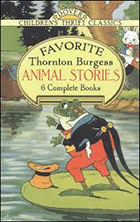 Thornton W. Burgess (1874–1965) had an enormous influence on me. Coming out of poor circumstances, he resolved to become a writer, focusing on the landscape and creatures that inhabited his childhood around Sandwich, Mass. By the time of his death, he had written some 170 books, and 15,000 stories. For the most part, they were anthropometric stories, written as bedtime tales.
Thornton W. Burgess (1874–1965) had an enormous influence on me. Coming out of poor circumstances, he resolved to become a writer, focusing on the landscape and creatures that inhabited his childhood around Sandwich, Mass. By the time of his death, he had written some 170 books, and 15,000 stories. For the most part, they were anthropometric stories, written as bedtime tales.
They are brilliantly constructed for the early reader. Each chapter: This is what is going to happen. This is what does happen. This is what I told you would happen.
I—a city boy—discovered him on the pages of the N.Y. Herald Tribune, where his books were serialized daily, chapter by chapter, along with illustrations by Harrison Cady. When I discovered that I could buy the complete books at a nearby used bookstore for twenty-five cents each, I began to build my first library.
Freddy the Fox, Blackie the Crow, Sammy Jay, Jimmy Skunk, Old Mother West Wind, The Laughing Brook, places and creatures that meant much to me. They were the first novels I read and I have absolutely no doubt that when I came to write my Poppy books, his vision was embedded in me and guided my hand.
When I first began to read chapter books to my eldest son, these were the books I read. In one saved volume, on the flyleaf it is written, “This is the first book I ever read on my own.” Signed (sort of) by that son. When my grandkids come to visit this summer, I shall read to them from these books. They are still in print, and very cheaply too.
Just today—it is May, early spring here in the mountains—I stood beside a tumbling creek, and listened to its sound. Into my head—after seventy years!—popped the words, “Laughing Brook.” It made me smile.
For any teacher with young students—a chapter a day of a Burgess story will make you all smile, too.
4 thoughts on “Laughing Brook”
I never read these books, but I recognized the animals’ names from my husband’s stories about his growing up. “Oh yes, Thornton Burgess,” he said just now when I read him this post. “He was the source of most of my knowledge about the natural world.” His grandfather, it seems, took the books as jumping off point for ongoing stories he told about the characters. And my husband took those stories as the inspiration for stories he told our son. A long way removed from the originals, no doubt, but I can’t believe Thornton Burgess would mind. .
Love this! As I said, I read them as I kid. I read them to my children. And I just had the pleasure of reading them to my grandchild. Read my Poppy Books, and you will find–I have no doubt–echoes of the stories there, too.
Thanks for sharing! I’ll go to the library to borrow it this week. Perfect for summer reading w/ my son. 🙂
Wow! Both Burgess’s stories and the Poppy series were childhood favorites of mine, much for the same reason: the interweaving of natural history and fiction in both struck a balance that I found very appealing. It’s amazing and somewhat surreal for me to find out that one fed into the production of the other. I also find it a very real reminder on the web of inspiration that connects each creative work to myriad others.